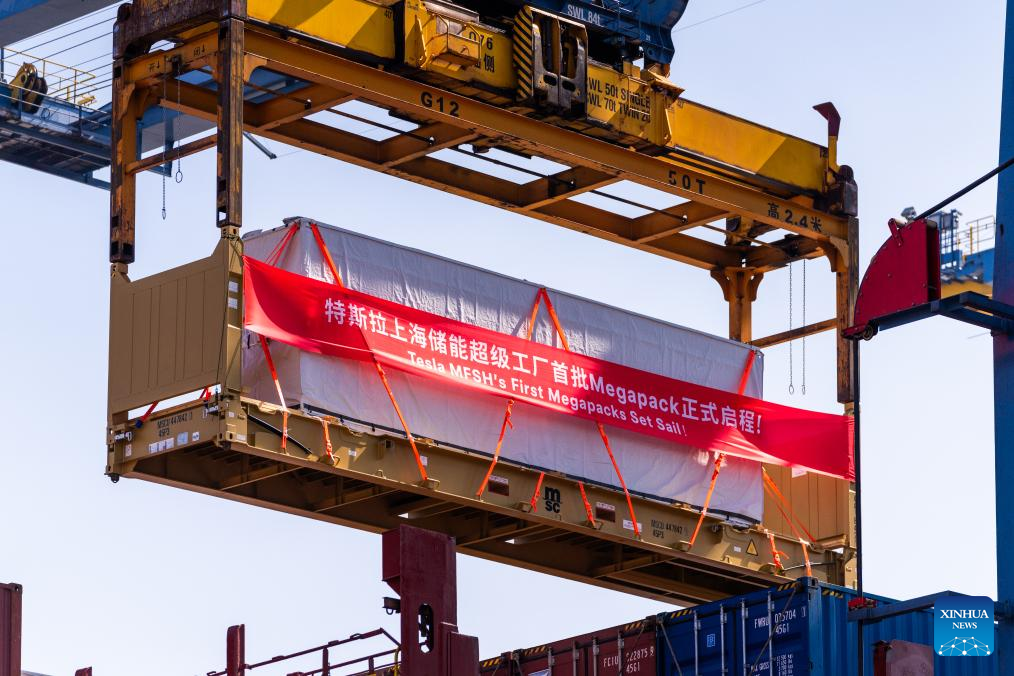
 0 Comment(s)
0 Comment(s) Print
Print E-mail Xinhua, March 22, 2025
E-mail Xinhua, March 22, 2025

This photo shows Megapack energy-storage batteries in east China's Shanghai, March 21, 2025. [Photo/Xinhua]
Tesla's new Megafactory in east China's Shanghai on Friday exported its first batch of Megapack energy-storage batteries, the company announced.
It took the new Megafactory just over a month after its production launch to achieve its first export, with the batteries being transported from Shanghai Port to Australia.
This export highlights Tesla's further expansion in the global energy storage market, and also underlines the extension of its battery technology from electric vehicles to energy storage, according to the company.
"Megafactory gives us the ability to scale production and efficiency," said Mike Snyder, vice president of Tesla. "We can lower logistics costs as well as product costs, and grow the business to new markets."
Booster to green transformation
An energy-storage system charges when wind power or solar power generates a large volume of electricity or when the power consumption is low, and discharges when power generation is low or consumption is high. It can smooth the unstable output of solar or wind power to increase the proportion of renewable energy in the grid.
Megapack is an electrochemical energy storage device that uses lithium batteries -- a dominant technical route in the new-type energy storage industry. This sector is characterized by short construction periods, flexible layouts and fast responses, when compared to conventional pump storage.
"The large-scale application of new-type energy storage systems like Megapacks will strengthen grid stability, security and economic efficiency, contributing to the green transition of the energy structure," said Zhang Yu, a senior expert at the State Grid Shanghai Municipal Electric Power Company.
Snyder has reaffirmed Tesla's commitment to supporting China's green transition. The executive added: "Tesla is not just an electric vehicle company. We're building a world powered by energy generation and storage products and transported by electric vehicles to accelerate the world's transition to sustainable energy."
The smooth production and export of the new Megafactory take Tesla's envision a step forward.
The Shanghai facility was built with an initial annual production capacity of 10,000 units. Notably, each Megapack unit can store over 3.9 megawatt-hours of energy -- sufficient to power approximately 3,600 households for one hour.
Tesla anticipates a year-on-year increase of at least 50 percent in its energy storage deployments in 2025.
The batteries produced at the factory will supply both the domestic and Asia-Pacific markets.
According to the General Administration of Customs (GAC), China's lithium battery exports reached 3.91 billion units in 2024, marking a record high. Last year, the country's export of wind turbines surged by 71.9 percent, and the photovoltaic product exports exceeded 200 billion yuan (about $27.9 billion) for four consecutive years.
"China's green products not only enrich global supply, but also make contributions to tackling climate change and green and low-carbon transformation," said Lyu Daliang, director of the GAC's Department of Statistics and Analysis.
Magnet for foreign investment
Hailed by the company as a "milestone," the new Megafactory is the first of its kind built by Tesla outside the United States and the company's second plant in Shanghai, following the inauguration of its Gigafactory in 2019.
Covering an area of approximately 200,000 square meters, the new Shanghai plant represents a total investment of about 1.45 billion yuan, according to the administration of the Lin-gang Special Area of China (Shanghai) Pilot Free Trade Zone, where the new Tesla facility is located.
Bai Ming, a researcher at the Chinese Academy of International Trade and Economic Cooperation, said the rapid operation of the Megafactory reflects the extensive opportunities that China provides to foreign companies.
"China, with its vast market, complete supply and industrial chains, and investor-friendly environment, will continue to be a top choice for global capital," Bai said.
As outlined in this year's government work report, China has pledged to encourage foreign-funded enterprises in China to reinvest in the country, strengthen services for foreign investors, and make China a favored destination for foreign investment.
In 2024, 59,080 new foreign-invested enterprises were established in China, up 9.9 percent year on year. Over the past five years, the return rate of foreign direct investment in China has remained at approximately 9 percent, ranking among the highest in the world.
"Numerous foreign enterprises in China are rejecting decoupling and supply chain disruption," Bai noted. "Their focus is on deepening collaboration with Chinese firms to achieve shared growth."